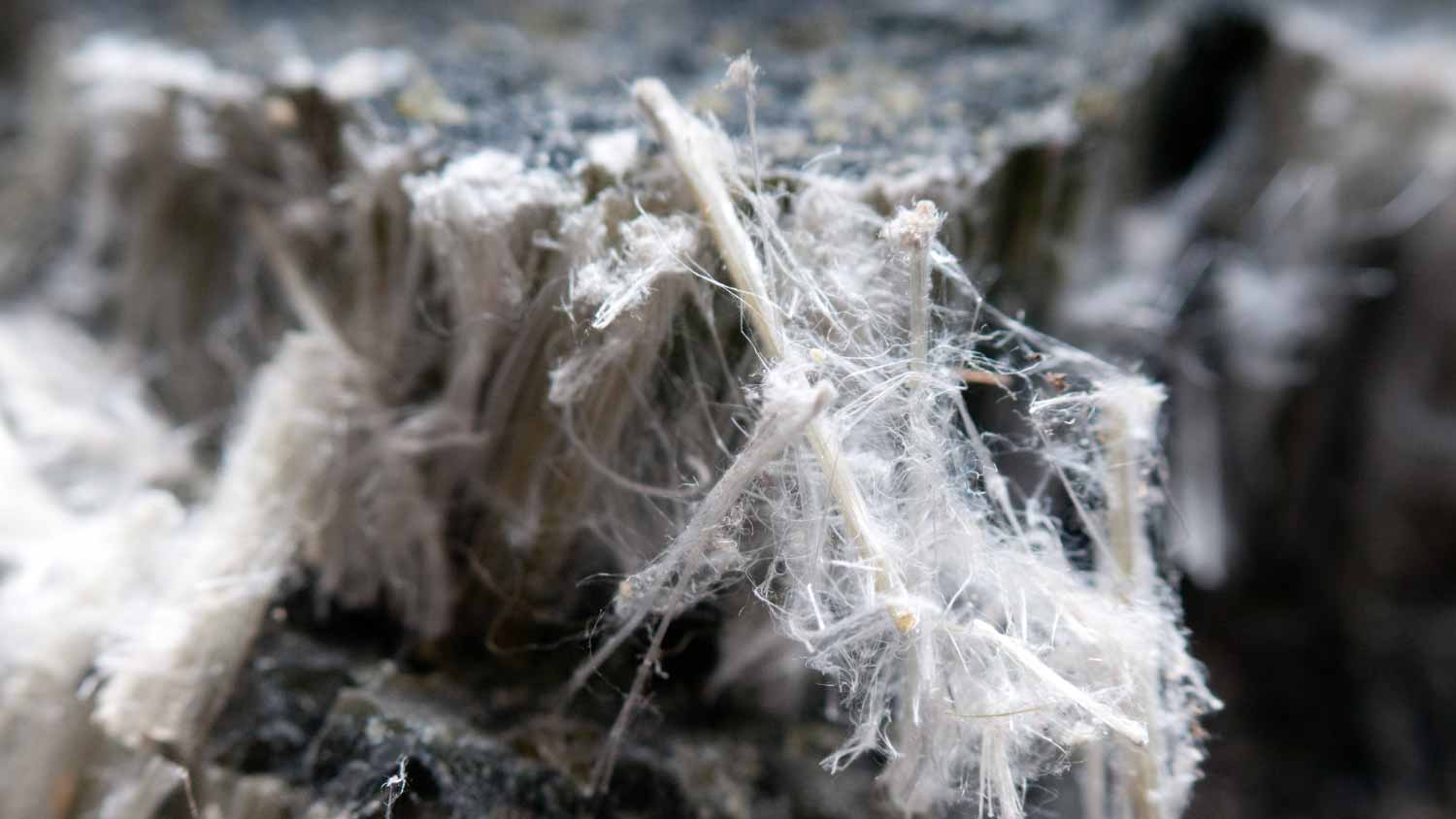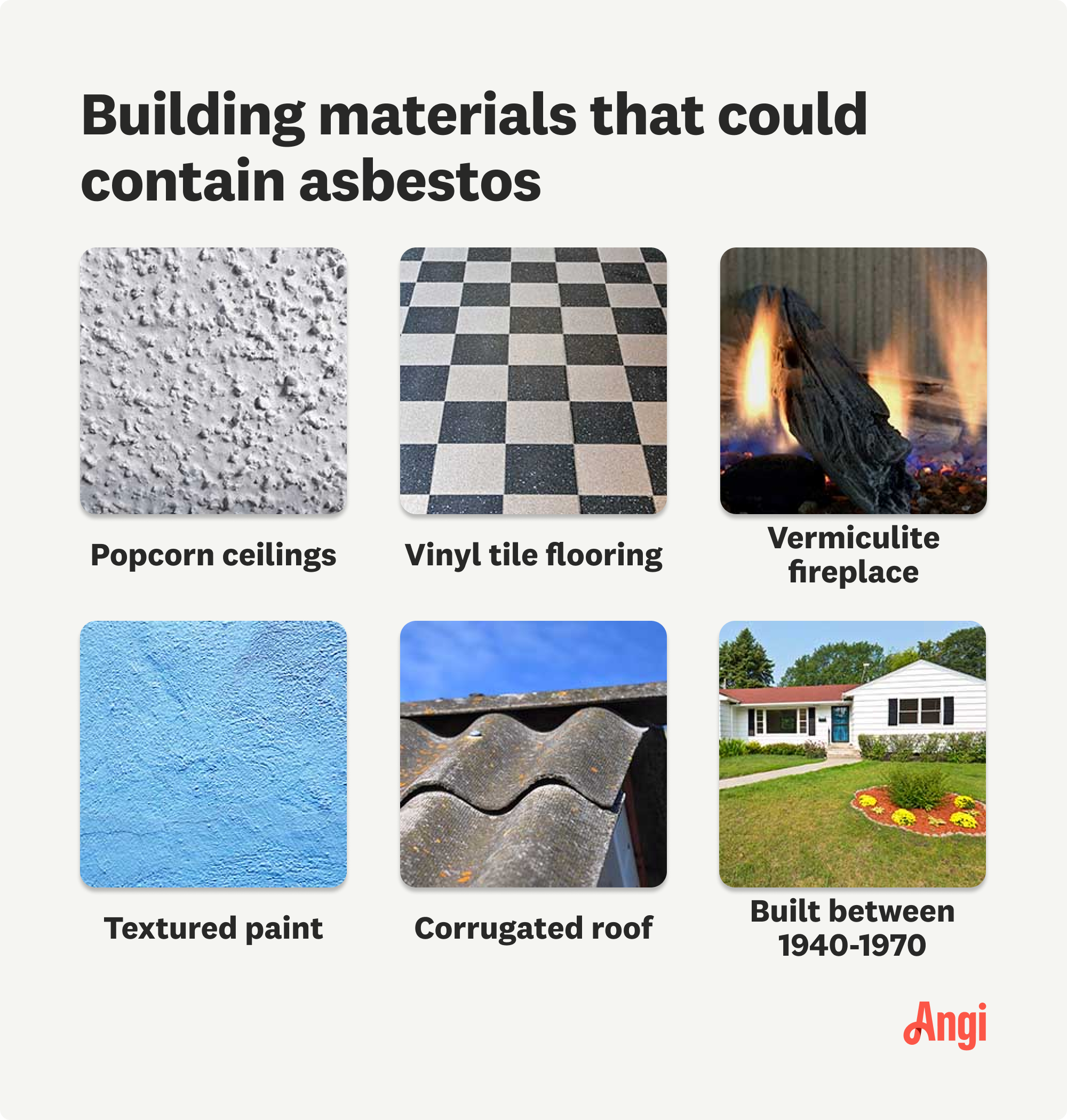
Drone roof inspection costs vary depending on the roof’s size, complexity, and material. Use this guide to budget for a drone roof inspection.
Eliminate asbestos guesswork with an inspection


Only qualified pros can check for asbestos.
Asbestos was frequently used to build homes pre-1980.
Asbestos exposure increases the risk of cancer.
An asbestos inspection costs between $280–$780.
Home inspectors have a checklist they examine to determine any potential issues or hazards with a house. But do home inspections check for asbestos? Surprisingly, they don’t. An inspector might identify areas suspected to have asbestos in your home—particularly if it’s an older house—but it’s not usually part of their inspection. Find out why general home inspections don’t check for asbestos and what you need to know if you have it in your home.
Unfortunately, standard home inspections don’t check for asbestos, and homeowners aren’t obligated to tell buyers about existing asbestos. To avoid liability, most home inspectors won’t closely examine areas that require specific expertise, which includes asbestos, as it can be tricky to detect. Special equipment and testing are needed to confirm the presence of asbestos, and it can only be done by qualified and licensed asbestos inspectors.

Asbestos is a naturally occurring mineral fiber that is heat- and chemical-resistant. Because of its fireproof qualities, it was widely used as a fire-retardant during the construction of homes and commercial buildings before the 1980s. Some common places where asbestos was used include:
Pipes
Vinyl sheet flooring
Roofs and shingles
Gas-fired fireplaces
Oil and coal furnaces
Paints
Boiler insulation
Vermiculite attic insulation
Ceiling tiles
Sheetrock
Siding shingles
According to the National Institute of Health (NIH), the International Agency for Research on Cancer (IARC) concluded in 1977 that asbestos qualifies as a carcinogen. It also revealed exposure to asbestos fibers is linked to an increased risk of lung cancer, mesothelioma, and asbestosis—a chronic lung condition caused by prolonged inhalation of asbestos fibers. Following these findings, the Occupational Health and Safety Administration (OSHA) and the Environmental Protection Agency (EPA) began to regulate the use of asbestos.
Since 2019, asbestos has been banned in the production of most building products including pipeline wrap, cement, adhesives and sealants, roofing felt and roof coatings, and millboard. In 2022, the EPA proposed a ban on the ongoing use of chrysotile asbestos that is currently imported into the U.S.
If you’re moving into a house built before 1980 and the idea of having asbestos in the home is a concern, it may be a good idea to schedule an inspection to test for asbestos. The same goes if you’re planning to renovate a home from this period. You stand a higher risk of breathing in asbestos fibers and general exposure if materials containing asbestos are disturbed during demolition and renovations.
The only way to know for sure if there’s asbestos in your home is to hire an asbestos professional. An asbestos inspector will review all structures in your home to assess their condition and take samples of various materials for testing. On average, an asbestos inspection costs $480, with a range from $280 to $780, depending on the size, condition, and location of your home.

You can hire a certified asbestos inspector or an environmental consultant to check your property for asbestos. These professionals are trained in the detection of asbestos by examining the property and safely collecting and testing samples. Some inspectors may work for companies that also contain and remove asbestos, though this is not always the case.
Many states provide certification for asbestos inspectors, so you can find a list of verified asbestos professionals in your state through the state government or the Environmental Protection Agency.
Radon is a very common, undetectable threat in homes, and it's not checked for in standard home inspections. A typical home inspection also won't check for other hazardous materials such as asbestos, radiation, formaldehyde, methane, and other substances. Many home inspection services will check for these hazards for an additional cost.
If an asbestos inspector determines the presence of asbestos in your home, what to do next depends on a couple of factors.
Asbestos is categorized as either friable or non-friable. Friable asbestos presents more of a risk because it can be easily crumbled or crushed into airborne fibers. Non-friable asbestos is safely maintained in a way that it can’t become airborne and is best left alone—it could become friable if disturbed.
However, in some instances, asbestos professionals can encapsulate an area with asbestos using a protective sealant to prevent it from becoming airborne. Look for a reputable asbestos testing company near you to handle the removal, conduct air tests, and conduct a thorough clean-up.
Most state laws require sellers to disclose any environmental problems, including asbestos, that are known to be in their homes. If a seller is aware of the presence of asbestos in the home and doesn’t disclose it, they could face legal action long after the sale of the home. If asbestos is discovered, the buyer and seller can negotiate whether or not the sale depends on the seller remediating the asbestos.
From average costs to expert advice, get all the answers you need to get your job done.

Drone roof inspection costs vary depending on the roof’s size, complexity, and material. Use this guide to budget for a drone roof inspection.

If you’re buying a home, having an inspection offers reassurance that it’s in good condition. How much a home inspection costs varies depending on the home's size, age, condition, and location.

Finalizing a new house build includes a walk-through with a home inspector and the builder. Here’s what to know about a new construction home inspection.

In a highly competitive market, you may wonder if waiving the home inspection is a good idea. Learn why it’s often not and what to consider before you do.

Learn about mobile home inspection costs and some additional costs you might have to pay so you can budget before moving in or closing on your new home.

Even a well-maintained home can have hazards for older adults. Learn how home inspections can help you reduce risks and stay safely in your home.